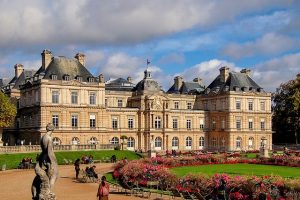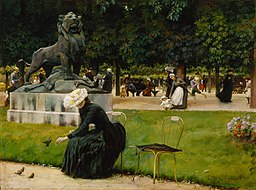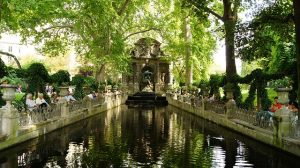|Le Jardin du Luxembourg|
Luxembourg Gardens Paris : Take a break and wander through the beautiful Luxembourg gardens. After a long day of walking or shopping, this is the perfect place to sit and lounge in the sun. Le Jardin du Luxembourg is nowadays owned by the French Senate, which is housed in the elegant Palace.
The Senate owner of the garden and palace
The palace and the garden are today the property of the Senate. It is the second “chamber” of the French Parliament, the first being the National Assembly. In France, with the 5th Republic, the legislative power is held by the Parliament, made up of the Senate and the National Assembly. It has the power to discuss and pass laws.
The two chambers of Parliament have exactly the same functions: to examine and amend laws in depth, to study major national questions and to monitor government action. But unlike the National Assembly, the Senate also defends the interests of municipalities, departments and regions, what are called “local authorities”. The National Assembly, for its part, has the final say on the passing of laws. This means that it is the one who decides in case the Senate and the Assembly disagree. Thus, to sum up, senators represent, investigate, deliberate, legislate and control.
The legislative power is one of the three powers, with the executive power and the judicial power, constituting the State in a democratic mode respecting the separation of powers.

Queen Marie de Médicis founder of the palace and garden
Acquired by Marie de Médicis between 1614 and 1631, the Luxembourg garden underwent many modifications, up to the works of Haussmann at the end of the Second Empire, which gave it its current layout. Marie de Médicis, wanted to move away from the tumult of the courtyard then installed in the Louvre Palace and decided to have a palace built surrounded by a sumptuous garden.
Marie de Medici (1575-1642) was a queen of France and Navarre from 1600 to 1610 by her marriage to Henri IV. Widowed in 1610, she assumed the regency in the name of her son, Louis XIII (father of Louis XIV with mother Anne D’Autriche), until 1614. She became head of the King’s Council following the bed of justice on 2 October 1614, until 1617, when his son took power. Chased by her son Louis XIII after the assassination of his adviser – very criticized – Concini, Marie de Médicis will find asylum in the Netherlands then in Cologne until the end of her life in 1642.
In France, the Medici (Italian Dynasty) gave two queens, and not the least: Catherine and Marie de Medici. Their exceptional destinies are curiously mixed and succeeded. Catherine and Marie de Médicis are two distant cousins whose common ancestor was Jean de Médicis, founder of the Medici dynasty at the end of the 14th century.
Luxembourg Gardens Paris Story
The current area of the estate – around 25 hectares – is roughly equivalent to that of the Marie de Médicis acquisitions, but its configuration has totally changed. It was not until the end of the Second Empire that the garden was installed in its current limits. In 1611, when the story of the Garden began, the suburb which extended to the south of the Saint-Michel and Saint-Germain gates, on the left bank of the Seine, was both a social and rural district.
Queen Marie de Medici loved this quiet suburb, more salubrious than the Louvre district and where eminent members of her Italian entourage lived. So it was there that she thought of taking up residence when she expressed her desire, after the assassination of Henry IV, to leave the Louvre. She therefore took care to acquire land large enough to build a home inspired by Florentine palaces and a park reminiscent of the Boboli gardens of Florence city, Italia, designed for the Medici. It represents one of the first and most important examples of the “Italian Garden”. In 1612 she bought the Hôtel du Duc François de Luxembourg and the 8 hectares attached to it.
The estate remained as it was until the Luxembourg Palace was given in prerogative to the Count of Provence. In order to pay for the restoration of the Palace, the western end of the gardens on the Notre-Dame-des-Champs side were sold. About ten hectares were sold in 1782, and the rue de Luxembourg, future rue Guynemer, was opened. The sacrificed alleys included the “Valley of the Philosophers” where Rousseau, host in 1741 in the Hôtel Saint-Quentin, rue Victor-Cousin, walked every morning exercising his memory.
Haussmann’s improvements were largely at the expense of the park, which was at first cut down by the widening of rue de Vaugirard and the opening of boulevard Saint-Michel. It was decided in 1865 to limit the garden to the south by an open street in the extension of the rue de l’Abbé-de-l’Epée, and to subdivide the nursery and the botanical garden.

Charles Courtney Curran – Dans le Jardin du Luxembourg (1889)
Luxembourg Gardens Paris in its current layout
Located in the sixth arrondissement of Paris between the Latin Quarter, Saint-Germain des Prés and Montparnasse, the Jardin du Luxembourg is one of the favorite green spaces for Parisians and tourists. It covers twenty-three hectares, twenty-one of which is open to the public. It holds :
- Magnifient buildings, sculptures and fontains
- Restaurants, ice cream corners and café
- Accessible lawn, flowers and botanical garden
- Playgrounds and activities for kids (pony ride, puppet theater…)
- Sports, leisure and discovery place (tennis court, museum…)
In 1830, an orangery was built in the garden, then gradually added an orchard, greenhouses, a rose garden and an apiary still used today and accessible to visitors. The garden is divided into a French part and an English part, separated by a forest and a large octagonal pond. One hundred and six statues and two sculpted fountains, the Medici Fountain and the Monument to Eugène Delacroix by Jules Dalou, are arranged in the park.
In terms of entertainment, you can practice chess, bridge, tennis, admire the works regularly exhibited on the outdoor grills, or simply sit on a chair and enjoy a moment ” in the green ”. The music kiosk offers eclectic programming in summer, children can rent remote-controlled boats that they maneuver on the basin, attend puppet theater performances, ride a pony or enjoy the playground.

Luxembourg Gardens Paris Museum
In 2010, the Senate delegated the management of the museum to the Réunion des musées nationaux – Grand Palais with the mission of organizing exhibitions. Three programming axes, linked to the history of the place, are privileged: “the Renaissance in Europe”, “art and power” and “the Palace, the Garden and the Museum”. The Luxembourg Museum was the first French museum open to the public in 1750, and from 1818 became the first museum of contemporary art. Its history is intimately linked to the Palais du Luxembourg, where it was first installed, and of the Senate.
It was in 1903 that the Austrian confectioner Antoine Rumpelmayer founded the Angelina tea room at 226 rue de Rivoli in Paris, baptized in honor of his daughter-in-law. Angelina quickly established herself as a Mecca for gourmet Parisian pleasures. Nowadays, you can enjoy the famous hot chocolate known as “the African” and the traditional Mont-Blanc with chestnut cream. from Angelina in the museum.
From the garden, the fountains, the Senate to the orangerie, the museum, ask us a tailor-madeParis private tour guide in Saint Germain.
Emy,


